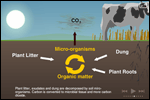Soil Health
A soil that is healthy delivers a wide range of ecosystem services and is less likely to be acidic, saline, compacted, losing nutrients, or eroding.
Different soils have different qualities. These qualities determine the level of a soils inherent potential to sustain biological productivity, maintain environmental quality, and promote plant and animal health. Soil health is the 'fitness' (or condition) of soil to achieve its inherent potential.
Soil health is a basic requirement for environmental health, human health, plant health, and animal health.

This page gives access to a range of information on soil health. The Soil health checklist sets-out information for the development of a Soil health management plan by bringing together inventory information, knowledge resources, testing methods, monitoring methods, and decision support tools. Links to other relevant documents and web sites are also provided.
What's New
| Nitrogen Cycle Nitrogen is present in the earth's atmosphere, hydrosphere, biosphere and geosphere. Approximately 78 % of the earth's atmosphere is nitrogen, however, atmospheric nitrogen is unavailable for biological use. Atmospheric nitrogen must undergo an important process called fixation to make it available for plants to use. The animation illustrates the steps of the nitrogen cycle. |  An animation of the nitrogen cycle |
| Carbon Cycle Carbon is essential to life on earth, with every living organism needing carbon to sustain life whether for physical structure, or as an energy source, or both. Carbon is quite mobile and cycles through the earth's atmosphere, oceans, biosphere and geosphere.' The animation illustrates the steps of the carbon cycle. |  An animation of the carbon cycle |


